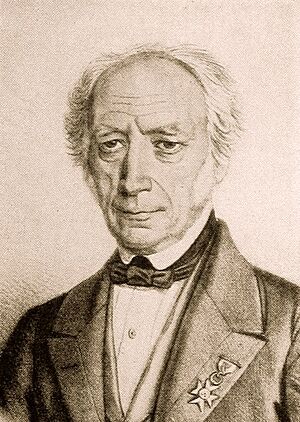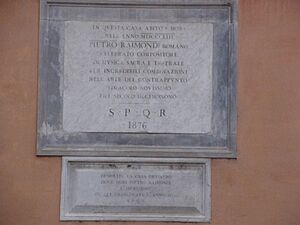Pietro Raimondi facts for kids
Pietro Raimondi was an Italian composer born in Rome on December 20, 1786. He lived during a time when music was changing from the Classical style to the Romantic style. Raimondi was known for his operas (musical plays) and sacred music (religious music). He was also special because he experimented with counterpoint (a way of combining different melodies) and created huge musical pieces meant to be played at the same time. He passed away on October 30, 1853.
Contents
Early Life and Musical Journey
Pietro Raimondi started his music education in Naples. He spent some of his early career in places like Genoa and Sicily. In Sicily, his operas were performed in cities like Catania and Messina. By 1820, he moved back to Naples and focused on writing operas.
Even though he was known for operas, Raimondi loved counterpoint. He spent his free time writing complex fugues. A fugue is a type of musical piece where different melodies are woven together. He even wrote fugues that could be played at the same time by different groups of instruments. He saw these as experiments and didn't use them in his early operas.
Changing Musical Direction
Not many of Raimondi's operas became big hits. When he saw that other composers like Rossini, Bellini, and Donizetti were becoming more famous for operas, he changed his focus. He started composing more sacred music. This allowed him to explore his love for counterpoint even more.
In 1836, he published a book about counterpoint. Around this time, he also started creating his experimental pieces for many choirs and orchestras. From then on, he spent most of his energy on these large-scale works. However, he still tried a few more times to succeed in the opera world.
The Amazing Triple Oratorio
One of Raimondi's most incredible experiments was his triple oratorio called Putifar-Giuseppe-Giacobbe. An oratorio is a large musical work for voices and orchestra, usually based on a religious story. This piece, finished in 1848, was actually three separate oratorios. They were designed to be performed one after another. But the most amazing part was that they could also be performed all at the same time!
This was a very unusual idea for his time. Raimondi's music followed traditional rules of counterpoint. The three parts were carefully made to fit together perfectly. The triple oratorio was first performed in Rome in 1852. The concert lasted six hours and needed 430 performers! People said that Raimondi was so overwhelmed by the huge sound of all three oratorios playing together at the end that he fainted. The concert was a big success and created the sensation he had hoped for.
Because of this success, the Pope honored him. Raimondi was given the important job of maestro di cappella (music director) at St. Peter's. This was a level of recognition he had never achieved with his operas.
Later Works and Legacy
After his triple oratorio, Raimondi started working on a double opera. This was meant to be one serious opera and one funny opera. Just like his oratorio, they could be performed separately or at the same time. This work, called Adelasia/I quattro rustici, was not finished when he passed away in 1853. However, he had planned out much of the music and how the scenes would work. The idea was that each opera would comment on the other.
This double opera has never been completed or performed. It, along with Raimondi's other late works, shows an experimental side of music in the mid-1800s that wasn't really continued by other composers. Raimondi's musical style itself was quite traditional. His simultaneous pieces worked because they followed old rules of counterpoint and stayed within a limited range of musical keys.
Raimondi also appears as a character in Michael Ayrton's funny novel Tittivulus.
See also
 In Spanish: Pietro Raimondi para niños
In Spanish: Pietro Raimondi para niños



